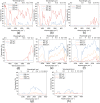UV-curable thiol-ene system for broadband infrared transparent objects
- PMID: 38104167
- PMCID: PMC10725491
- DOI: 10.1038/s41467-023-44273-0
UV-curable thiol-ene system for broadband infrared transparent objects
Abstract
Conventional infrared transparent materials, including inorganic ceramic, glass, and sulfur-rich organic materials, are usually processed through thermal or mechanical progress. Here, we report a photo-curable liquid material based on a specially designed thiol-ene strategy, where the multithiols and divinyl oligomers were designed to contain only C, H, and S atoms. This approach ensures transparency in a wide range spectrum from visible light to mid-wave infrared (MWIR), and to long-wave infrared (LWIR). The refractive index, thermal properties, and mechanical properties of samples prepared by this thiol-ene resin were characterized. Objects transparent to LWIR and MWIR were fabricated by molding and two-photon 3D printing techniques. We demonstrated the potential of our material in a range of applications, including the fabrication of IR optics with high imaging resolution and the construction of micro-reactors for temperature monitoring. This UV-curable thiol-ene system provides a fast and convenient alternative for the fabrication of thin IR transparent objects.
© 2023. The Author(s).
Conflict of interest statement
The authors declare no competing interests.
Figures







References
-
- Badakis, G., Koutsoubelias, M. & Lalis, S. In 2021 IEEE Sensors Applications Symposium (SAS). 1-6. 10.1109/SAS51076.2021.9530091.
-
- Hussain R, Zeadally S. Autonomous cars: Research results, issues, and future challenges. IEEE Commun. Surv. Tutor. 2019;21:1275–1313. doi: 10.1109/COMST.2018.2869360. - DOI
-
- Coffey VC. Seeing in the dark: Defense applications of IR imaging. Opt. Photon. N. 2011;22:26–31. doi: 10.1364/OPN.22.4.000026. - DOI
-
- Rieke GH, et al. The mid-infrared instrument for the james webb space telescope, i: Introduction. Publ. Astronomical Soc. Pac. 2015;127:584. doi: 10.1086/682252. - DOI
Grants and funding
LinkOut - more resources
Full Text Sources

